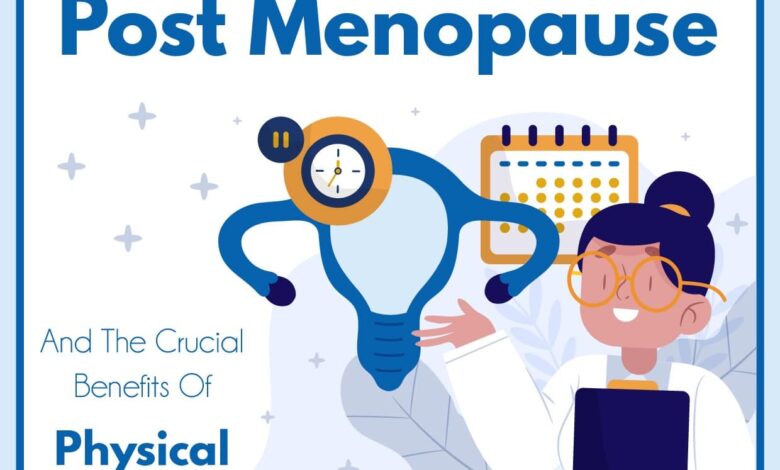
Positive Changes During the Postmenopausal Period
Positive changes during the post menopausal period – Positive changes during the postmenopausal period: It’s a phrase that might seem contradictory at first. We often hear about the challenges – hot flashes, weight gain, mood swings – but what about the unexpected positives? This isn’t about ignoring the difficulties, but rather about shifting our perspective and embracing the opportunities this new chapter offers. This journey isn’t just about managing symptoms; it’s about discovering a renewed sense of self, stronger relationships, and a richer life experience.
Postmenopause marks a significant transition, a time of physical and emotional shifts. While some changes might be initially unsettling, they also pave the way for unexpected growth and freedom. This exploration delves into the positive aspects, offering practical strategies and inspiring stories to help navigate this stage with confidence and grace. We’ll explore everything from boosting physical health and managing emotional well-being to fostering stronger connections and embracing new opportunities for personal growth.
Physical Health Transformations

Source: ocdn.eu
Postmenopause marks a significant shift in a woman’s life, bringing with it a range of physical changes. While some of these changes can feel challenging, it’s important to remember that they are a natural part of aging and can be managed effectively to maintain a high quality of life. By embracing a proactive approach to health and well-being, we can navigate this transition with strength and grace.Many women experience a decrease in estrogen levels during postmenopause, leading to various physical changes.
These can include weight gain, particularly around the abdomen; changes in skin elasticity and texture; decreased muscle mass and bone density; and vaginal dryness. However, viewing these changes through a positive lens focuses on proactive strategies for mitigating negative effects and enhancing overall health.
Managing Weight Gain
Weight gain during postmenopause is a common concern, often linked to hormonal shifts and a slowing metabolism. However, adopting a balanced diet rich in fruits, vegetables, lean proteins, and whole grains can help manage weight effectively. Regular exercise, especially strength training, boosts metabolism and builds muscle mass, which in turn helps burn more calories at rest. Focusing on mindful eating, paying attention to hunger and fullness cues, can also aid in weight management.
For example, switching from sugary drinks to water or unsweetened tea can significantly reduce daily calorie intake.
Maintaining Bone Density and Muscle Mass
Osteoporosis and muscle loss (sarcopenia) are significant risks during postmenopause. However, proactive strategies can greatly reduce these risks. Weight-bearing exercises, such as walking, hiking, and dancing, stimulate bone growth and improve bone density. Strength training, using weights or resistance bands, builds and maintains muscle mass, which is crucial for strength, balance, and preventing falls. A diet rich in calcium and vitamin D is also essential for bone health.
Consider incorporating foods like leafy greens, dairy products, and fortified cereals. Supplementation with calcium and vitamin D might be necessary, depending on individual needs and dietary intake; consult your doctor for personalized advice.
A Sample Weekly Exercise Plan
A balanced exercise routine is key to maintaining physical health during postmenopause. The following plan incorporates strength training, cardiovascular exercise, and flexibility work. Remember to consult your doctor before starting any new exercise program.
| Day | Time | Activity | Duration |
|---|---|---|---|
| Monday | Morning | Brisk Walking | 30 minutes |
| Tuesday | Evening | Strength Training (full body) | 45 minutes |
| Wednesday | Morning | Yoga or Pilates | 30 minutes |
| Thursday | Evening | Swimming or Cycling | 45 minutes |
| Friday | Morning | Brisk Walking | 30 minutes |
| Saturday | Morning | Rest or light activity (e.g., gardening) | As desired |
| Sunday | Morning | Rest or light activity (e.g., gentle stretching) | As desired |
Emotional and Mental Well-being

Source: paramedicsworld.com
Postmenopause isn’t just about physical changes; it’s a significant life transition impacting emotional and mental well-being. Hormonal fluctuations can trigger a rollercoaster of feelings, from irritability and anxiety to sadness and even depression. Understanding these shifts and developing healthy coping strategies is crucial for navigating this phase gracefully and positively. Remember, it’s perfectly normal to experience emotional ups and downs, and seeking support doesn’t indicate weakness; it’s a sign of strength and self-awareness.Emotional shifts during postmenopause are multifaceted and often linked to the decline in estrogen and progesterone.
These hormonal changes can affect neurotransmitter production, influencing mood regulation and impacting sleep patterns, which further exacerbates emotional instability. Reframing these experiences involves acknowledging the hormonal influence on your emotions without letting them define you. Instead of viewing mood swings as personal failings, recognize them as a natural consequence of physiological changes. Focus on self-compassion and actively practice self-care to support your emotional well-being during this time.
Celebrate small victories, practice gratitude, and maintain a positive self-image.
Coping Mechanisms for Stress, Anxiety, and Mood Changes
Managing stress, anxiety, and mood fluctuations during postmenopause requires a multi-pronged approach. The following techniques, implemented consistently, can significantly improve emotional resilience and overall well-being.
- Regular Exercise: Physical activity releases endorphins, natural mood boosters. Aim for at least 30 minutes of moderate-intensity exercise most days of the week. This could include brisk walking, swimming, cycling, or yoga.
- Mindfulness and Meditation: Practicing mindfulness helps you become more aware of your thoughts and feelings without judgment, reducing stress and anxiety. Even a few minutes of daily meditation can make a difference.
- Healthy Diet: Nourishing your body with a balanced diet rich in fruits, vegetables, and whole grains provides the essential nutrients for optimal brain function and mood regulation. Limit processed foods, sugar, and caffeine.
- Sufficient Sleep: Aim for 7-8 hours of quality sleep each night. Establish a regular sleep schedule and create a relaxing bedtime routine to improve sleep quality.
- Social Connection: Maintaining strong social connections is vital for emotional well-being. Spend time with loved ones, join social groups, or volunteer to foster a sense of belonging and support.
- Cognitive Behavioral Therapy (CBT): CBT is a type of therapy that helps you identify and change negative thought patterns and behaviors contributing to anxiety and depression. A therapist can guide you through this process.
- Stress Management Techniques: Explore techniques like deep breathing exercises, progressive muscle relaxation, or journaling to manage stress effectively.
Resources and Support Systems
Navigating postmenopause doesn’t have to be a solitary journey. Numerous resources and support systems are available to assist women during this life stage.
- Healthcare Providers: Your doctor or gynecologist can provide medical advice, monitor your health, and refer you to specialists if needed. Open communication with your healthcare provider is crucial.
- Therapists and Counselors: Mental health professionals can offer support and guidance in managing emotional challenges, such as anxiety, depression, or stress. They can teach coping skills and provide a safe space for processing emotions.
- Support Groups: Connecting with other women experiencing postmenopause can provide valuable emotional support, shared experiences, and practical advice. Many online and in-person support groups are available.
- Online Resources: Numerous websites and online communities offer information, advice, and support related to postmenopause. However, always verify the credibility of the source.
A Self-Care Plan Incorporating Mindfulness and Stress Reduction
Creating a personalized self-care plan is essential for managing emotional and mental well-being during postmenopause. This plan should incorporate mindfulness practices and stress-reduction techniques tailored to your individual needs and preferences. For example:
“My self-care plan includes a 15-minute mindfulness meditation each morning, a 30-minute walk in nature three times a week, regular yoga sessions, and weekly time dedicated to a hobby I enjoy, such as painting. I also prioritize sufficient sleep and maintain open communication with my support network.”
This is a sample plan; adapt it to fit your lifestyle and preferences. Consistency is key; even small acts of self-care contribute to a significant positive impact on your overall well-being. Remember that self-care is not selfish; it’s essential for maintaining your physical and emotional health.
Relationships and Social Connections

Source: hhands.net
Postmenopause marks a significant life stage, and while physical and mental changes are prominent, its impact on relationships and social connections is equally important. This phase can present both challenges and opportunities to redefine and strengthen bonds with loved ones, and to cultivate new connections that enrich our lives. Understanding these dynamics allows us to navigate this transition with grace and build fulfilling relationships.
Impact of Postmenopause on Intimate Relationships
Changes in libido, mood fluctuations, and physical symptoms associated with menopause can sometimes affect intimacy. However, open communication and a willingness to adapt are key to maintaining a strong and fulfilling intimate relationship. Many couples find that this period offers an opportunity to rediscover intimacy in new ways, focusing on emotional connection and non-sexual affection. For example, couples might prioritize shared activities, such as long walks, cooking together, or engaging in hobbies they both enjoy, strengthening their bond beyond physical intimacy.
This shift in focus can lead to a deeper understanding and appreciation of each other. Moreover, seeking professional guidance from a therapist specializing in relationship counseling can provide valuable tools and strategies for navigating this transition together.
Strategies for Maintaining Strong Connections with Family and Friends
Maintaining strong family and friend connections is vital for overall well-being during and after menopause. Prioritizing regular communication, even if it’s just a quick phone call or text message, is crucial. Scheduling regular visits or outings, whether it’s a weekly coffee date with a friend or a monthly family dinner, strengthens bonds and provides emotional support. Sharing experiences and actively listening to each other’s concerns fosters a sense of belonging and mutual understanding.
Actively participating in family events and gatherings, offering support to family members, and celebrating milestones together strengthens family ties.
Fostering New Social Connections and Community Participation
Postmenopause can be an ideal time to explore new interests and meet like-minded individuals. Joining clubs or groups based on hobbies, such as book clubs, hiking groups, or volunteer organizations, provides opportunities to forge new friendships and build a sense of community. Taking classes, whether it’s a pottery class, a language course, or a fitness program, offers a chance to meet new people and learn new skills.
Participating in community events, such as local festivals or volunteering at a charity, allows for social interaction and contributes to a sense of purpose. Online communities and forums focused on menopause or shared interests also provide a platform to connect with others going through similar experiences.
Activities that Encourage Social Interaction and Personal Growth
Participating in activities that promote both social interaction and personal growth is beneficial during postmenopause.
- Joining a book club or a writing group to share literary interests and engage in intellectual discussions.
- Taking a dance class or joining a fitness group to improve physical health and meet new people.
- Volunteering at a local charity or community organization to contribute to a cause and connect with others.
- Participating in a crafting group or art class to express creativity and share skills.
- Joining a hiking or walking group to enjoy nature and socialize with others.
- Attending workshops or seminars on topics of personal interest to expand knowledge and meet new people.
- Taking a cooking class or joining a wine tasting group to explore culinary interests and socialize.
New Opportunities and Personal Growth
Postmenopause, while often associated with physical changes, can surprisingly serve as a powerful catalyst for personal growth and self-discovery. This stage of life offers a unique opportunity to re-evaluate priorities, pursue long-dormant passions, and redefine what it means to thrive. The shift in hormonal balance can actually lead to a renewed sense of clarity and focus, allowing women to embark on new adventures with a fresh perspective.This period often marks a time of increased self-awareness and a desire for greater fulfillment.
Freed from the demands of child-rearing or intense career climbs (depending on individual circumstances), many women find themselves with more time and energy to dedicate to personal pursuits. This newfound freedom, combined with a deeper understanding of their own needs and desires, empowers them to make significant positive changes in their lives.
Examples of Women Embracing Postmenopause Positively
The transition into postmenopause doesn’t have to be a period of decline; it can be a launchpad for exciting new beginnings. Many women have successfully navigated this life stage, transforming challenges into opportunities for personal growth and fulfillment. Here are a few examples:
Example 1: Dr. Eleanor Vance
-After retiring from a successful career as a surgeon at age 60, Dr. Vance, always passionate about art, enrolled in a painting program. She found immense satisfaction in this new creative outlet, leading to several local exhibitions and even a small gallery showing of her work. Her post-menopausal journey allowed her to cultivate a long-suppressed creative talent, leading to a vibrant and fulfilling second act.
The colors she used in her paintings reflected her feelings of newfound freedom and serenity.
Example 2: Maria Rodriguez
-At 55, Maria, a former teacher, felt a yearning for more adventure. She used her savings to travel extensively, exploring different cultures and expanding her worldview. Her experiences broadened her perspective and strengthened her resilience. She started a blog documenting her travels, connecting with like-minded individuals worldwide. This phase in her life instilled a deep sense of independence and self-confidence.
Career Changes and New Hobbies
Postmenopause can be an ideal time to explore new career paths or cultivate enriching hobbies. The increased free time and the shift in priorities can lead to a reassessment of professional goals.
Many women find themselves pursuing careers that align more closely with their values and passions. This could involve starting a small business, transitioning to a less demanding role, or returning to education to acquire new skills. Examples include starting a freelance writing business, becoming a life coach, or pursuing a master’s degree in a field of personal interest. Hobbies, too, can significantly enhance well-being, fostering creativity, reducing stress, and building social connections.
These could range from pottery and gardening to volunteering and joining book clubs.
Redefining Personal Goals and Aspirations
The postmenopausal period necessitates a re-evaluation of personal goals and aspirations. It’s a time to let go of unrealistic expectations and focus on what truly matters.
This might involve setting new fitness goals, focusing on strengthening relationships, prioritizing self-care, or pursuing spiritual growth. It’s about defining success on your own terms, rather than adhering to societal pressures or past expectations. For instance, a woman might redefine success not by career advancement, but by building stronger family bonds, pursuing a passion project, or contributing to her community.
This shift in focus leads to a more authentic and fulfilling life.
Financial and Practical Considerations: Positive Changes During The Post Menopausal Period
Postmenopause marks a significant life stage, bringing with it not only physical and emotional changes but also important financial and practical considerations. Successfully navigating this period requires proactive planning and a clear understanding of the resources available. Failing to address these aspects can lead to unnecessary stress and compromise your overall well-being. This section focuses on strategies to ensure long-term financial security and access to appropriate healthcare.Planning for long-term financial security during and after postmenopause is crucial.
This involves reviewing your current financial situation, anticipating potential future expenses related to healthcare, and adjusting your savings and investment strategies accordingly. Many women find this stage coincides with children leaving home, potentially reducing household expenses, but also with increased healthcare costs. It’s a good time to reassess retirement plans, consider long-term care insurance, and ensure your estate planning is up-to-date.
For example, a woman who anticipates higher healthcare costs in her 60s and 70s might increase her retirement savings contributions or explore additional investment options to offset these expenses.
Health Insurance and Preventative Care
Maintaining comprehensive health insurance is paramount during and after postmenopause. This life stage often brings increased risks of certain health conditions, such as osteoporosis, cardiovascular disease, and certain types of cancer. Preventative care, including regular check-ups and screenings, plays a vital role in early detection and management of these conditions, potentially reducing long-term healthcare costs and improving quality of life.
For instance, timely detection of osteoporosis through bone density scans can allow for early intervention, slowing bone loss and reducing the risk of fractures. Choosing a health plan that covers necessary screenings and treatments is a key element of financial planning in this life stage.
Essential Health Screenings and Consultations
It’s essential to schedule regular check-ups and screenings tailored to the specific health risks associated with postmenopause. This proactive approach can significantly improve health outcomes and reduce long-term healthcare costs.
- Annual physical examination, including blood pressure, cholesterol, and blood sugar checks.
- Bone density scan (DEXA scan) to assess osteoporosis risk.
- Mammogram and/or breast MRI, based on individual risk factors and family history.
- Colonoscopy or other colorectal cancer screening.
- Pap smear and pelvic exam.
- Consultation with a gynecologist to discuss hormone replacement therapy (HRT) if needed.
- Eye exam to check for age-related vision changes.
- Dental check-up.
Navigating Practical Aspects of Postmenopause
Successfully navigating the practical aspects of postmenopause involves accessing and utilizing relevant resources and support systems. This can encompass everything from finding reliable information about managing menopausal symptoms to understanding and accessing available financial assistance programs.
- Support Groups: Connecting with other women experiencing postmenopause can provide invaluable emotional and practical support. Many local organizations and online communities offer such support.
- Healthcare Professionals: Regular consultations with a gynecologist, primary care physician, and other specialists as needed, are crucial for ongoing health management.
- Financial Advisors: Consulting a financial advisor can help with planning for retirement and managing healthcare costs.
- Government Resources: Explore government websites and resources for information on Medicare, Medicaid, and other healthcare and financial assistance programs.
Illustrative Examples of Positive Change
Postmenopause doesn’t have to be a period of decline. Many women embrace this life stage as an opportunity for growth and transformation. The following examples illustrate how women have successfully navigated the challenges and emerged stronger, healthier, and happier. These are not isolated cases, but rather represent the experiences of countless women who have actively shaped their postmenopausal journey.
Physical Health Transformations: Improved Fitness and Nutrition
Sarah, a 55-year-old accountant, experienced significant weight gain during perimenopause. Concerned about her health, she consulted a nutritionist who helped her create a balanced meal plan focusing on whole foods and portion control. Simultaneously, she joined a fitness class specifically designed for women over 50, incorporating low-impact exercises like yoga and water aerobics. Within a year, Sarah lost weight, increased her energy levels, and improved her bone density.
Her actions – seeking professional guidance and adopting a holistic approach to health – led to significant physical improvements.
Emotional and Mental Well-being: Embracing Self-Care and Mindfulness
Following menopause, Maria, a 62-year-old retired teacher, felt overwhelmed by mood swings and anxiety. She started practicing mindfulness meditation daily, utilizing guided meditation apps and attending local mindfulness workshops. She also prioritized self-care, incorporating activities she enjoyed, such as gardening and painting, into her routine. This holistic approach helped her manage her emotional fluctuations and fostered a greater sense of self-awareness and inner peace.
Her dedication to self-care practices significantly improved her mental and emotional well-being.
Relationships and Social Connections: Strengthening Bonds and Forging New Ones
After menopause, Lisa, a 58-year-old marketing executive, found herself with more free time and a renewed sense of self. She reconnected with old friends, joined a book club, and volunteered at a local animal shelter. These activities fostered deeper relationships with existing friends and helped her build new social connections. The increased social interaction combatted feelings of isolation and contributed to a stronger sense of community and belonging.
Her proactive engagement in social activities enriched her life considerably.
New Opportunities and Personal Growth: Pursuing Passions and Education
Following a successful career, Anna, a 60-year-old lawyer, felt a desire for a change. She enrolled in a pottery class, rediscovering a childhood passion. This new hobby not only provided creative outlet but also helped her meet new people and build confidence. She also pursued further education, taking online courses in creative writing. This pursuit of personal interests and continuous learning led to a renewed sense of purpose and fulfillment.
Anna’s example demonstrates that postmenopause can be a time for exploring new passions and personal growth.
Financial and Practical Considerations: Planning for the Future and Seeking Support, Positive changes during the post menopausal period
Upon retirement, Jane, a 65-year-old nurse, recognized the importance of financial planning for her postmenopausal years. She consulted a financial advisor to review her retirement savings and develop a long-term financial strategy. She also researched government assistance programs for seniors. This proactive approach ensured her financial security and reduced stress related to financial uncertainties. Jane’s story underscores the importance of planning and seeking professional help in managing financial aspects of postmenopause.
Conclusion
Embracing the postmenopausal period isn’t about denying the challenges; it’s about acknowledging them and finding strength in the process. By focusing on positive changes, adopting healthy habits, and nurturing our relationships, we can transform this life stage into a time of remarkable growth and fulfillment. The journey might involve adjustments, but the rewards – increased self-awareness, stronger bonds, and a renewed sense of purpose – are well worth the effort.
This is your time to redefine what’s possible and embrace the next chapter with open arms and a confident heart.
FAQ Overview
What are some common misconceptions about postmenopause?
Many believe postmenopause is solely defined by negative symptoms. The reality is that it’s a diverse experience, with significant potential for positive change and personal growth alongside the challenges.
Is it normal to experience anxiety or depression during postmenopause?
Yes, hormonal shifts can impact mood. It’s important to seek support if you’re struggling. Therapy, lifestyle changes, and support groups can be incredibly helpful.
How can I maintain a healthy sex life during postmenopause?
Open communication with your partner, exploring different intimacy options, and considering vaginal lubricants or hormone therapy (if appropriate) can all contribute to a fulfilling sex life.
How can I improve my sleep during postmenopause?
Establish a regular sleep schedule, create a relaxing bedtime routine, and consider strategies like cognitive behavioral therapy for insomnia (CBT-I) if needed.





